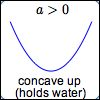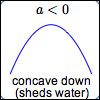 Review of Quadratic Functions: Vertex Form, Max/Min, Intercepts, More
Review of Quadratic Functions: Vertex Form, Max/Min, Intercepts, More
Let $\,a\,,$ $\,b\,$ and $\,c\,$ be real numbers, with $\,a \ne 0\,.$
A quadratic function is a function that can be written in the form $\,y = ax^2 + bx + c\,.$ This is called the standard form of the quadratic function.
Every quadratic function can also be written in the form $\,y=a{(x-h)}^2 + k\,.$ This is called the vertex form of the quadratic function.
For a thorough review of quadratic functions, including going from standard to vertex form, read Quadratic Functions and the Completing the Square Technique.
Summary: Properties of Quadratic Functions
GRAPH |
|
|
$y = ax^2 + bx + c\,$:
(standard form) ($a\ne 0$) |
Every quadratic function graphs as a parabola, which has beautiful and important reflecting properties. 

If you want to know the focus and directrix of $\,y = a(x-h)^2 + k\,,$ read Equations of Simple Parabolas. |
|
$y = a(x-h)^2 + k\,$:
(vertex form) ($a\ne 0$) |
|
| Comments: |
For $\,a \gt 0\,,$ $$ \cssId{s22}{\underbrace{a(x-h)^2}_{\ge 0} + k \overset{\text{always!}}{\ge} k} $$Thus, $\,k\,$ is a global minimum value. For $\,a \lt 0\,,$ $$ \cssId{s25}{\underbrace{a(x-h)^2}_{\le 0} + k \overset{\text{always!}}{\le} k} $$Thus, $\,k\,$ is a global maximum value. |
VERTEX (Turning Point) |
|
|
$y = ax^2 + bx + c\,$:
(standard form) ($a\ne 0$) |
Let $\,f(x) = ax^2 + bx + c\,,$ with $\,a\ne 0\,.$ The vertex is: $$ \cssId{s29}{\left(-\frac{b}{2a}\ ,\ f\bigl(-\frac{b}{2a}\bigr)\right)} $$This is sometimes called the vertex formula, and is worth memorizing. It can be derived by completing the square; or, it's really easy with a bit of calculus! |
|
$y = a(x-h)^2 + k\,$:
(vertex form) ($a\ne 0$) |
The vertex is: $(h,k)$ Note how easy it is to get the vertex from this form! Hence, the name ‘vertex form’ is appropriate. |
| Comments: | There is a horizontal tangent line at the vertex. |
$y$-INTERCEPT |
|
|
$y = ax^2 + bx + c\,$:
(standard form) ($a\ne 0$) |
When $\,x = 0\,$:
$$\begin{align}
y &= a\cdot 0^2 + b\cdot 0 + c\cr
&= c
\end{align}
$$
|
|
$y = a(x-h)^2 + k\,$:
(vertex form) ($a\ne 0$) |
When $\,x = 0\,$:
$$\begin{align}
y &= a(0 - h)^2 + k\cr
&= ah^2 + k
\end{align}$$
|
| Comments: | To find where a graph crosses the $y$-axis, set $\,x = 0\,$ and solve for $\,y\,.$ |
$x$-INTERCEPT(S) |
|
|
$y = ax^2 + bx + c\,$:
(standard form) ($a\ne 0$) |
Use the Quadratic Formula, as needed:
$ax^2 + bx + c = 0\ $ and $\ a\ne 0$ 
$b^2 - 4ac = 0\,$
$ax^2 + bx + c = 0$ 
$b^2 - 4ac \gt 0$
$ax^2 + bx + c = 0$ 
$b^2 - 4ac \lt 0$
$ax^2 + bx + c = 0$ |
|
$y = a(x-h)^2 + k\,$:
(vertex form) ($a\ne 0$) |
Easiest: isolate the squared expression; correctly ‘undo’ the square. Example: $$ \begin{gather} \cssId{s66}{0 = 2(x-1)^2 -5}\cr\cr \cssId{s67}{5 = 2(x-1)^2}\cr\cr \cssId{s68}{\frac 52 = (x-1)^2}\cr\cr \cssId{s69}{x-1 = \pm\sqrt{\frac{5}{2}}} \cr\cr \cssId{s70}{x = 1\pm\sqrt{\frac{5}{2}}} \end{gather} $$Need help with the last couple steps? Study: |
| Comments: | To find where a graph crosses the $x$-axis, set $\,y = 0\,$ and solve for $\,x\,.$ |
Use the following Wolfram Alpha widgets to graph and compute properties of quadratic functions. After pressing ‘Submit’ be sure to scroll down to see the graphs!